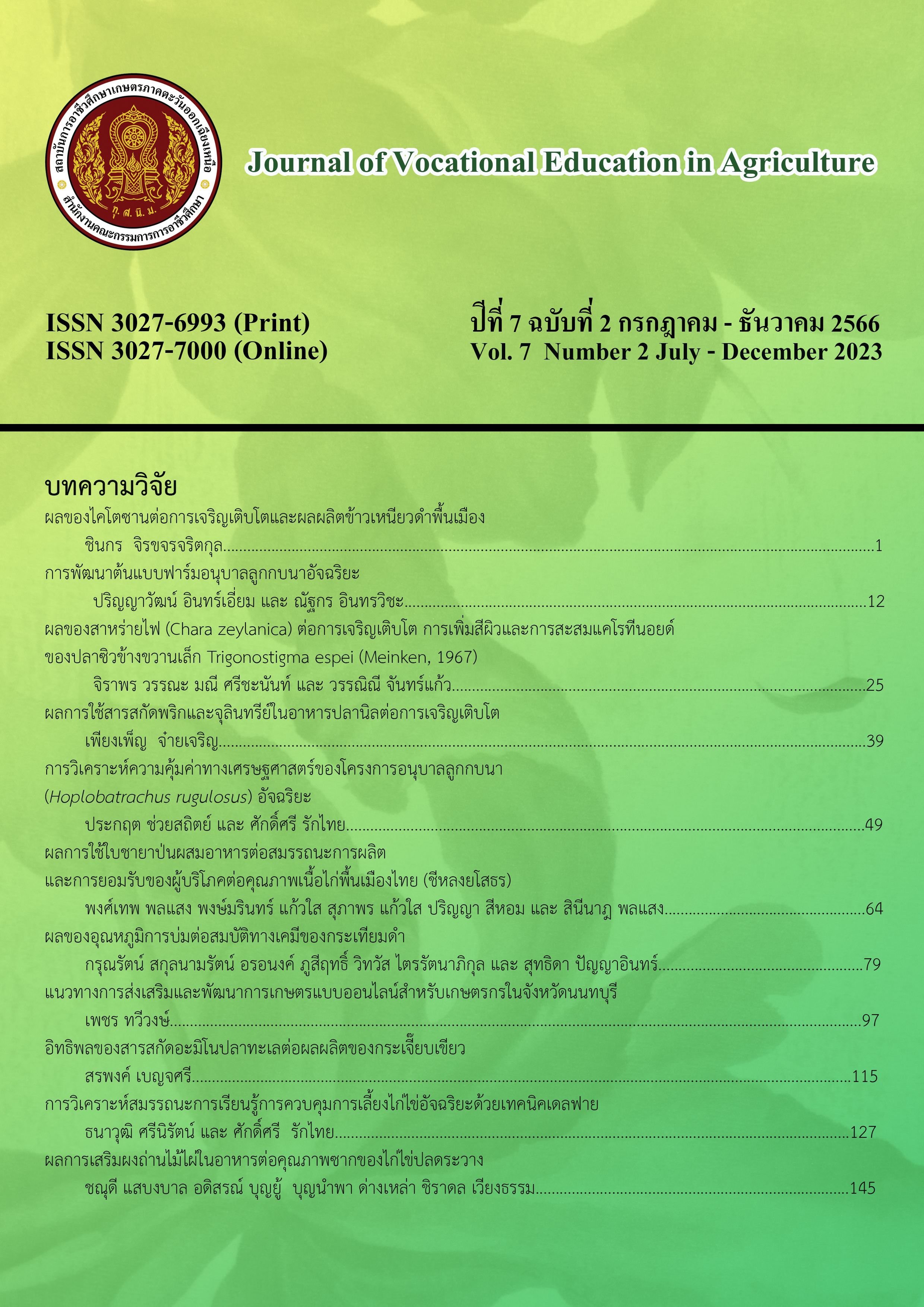ผลการใช้สารสกัดพริกและจุลินทรีย์ในอาหารปลานิล ต่อการเจริญเติบโต
Main Article Content
บทคัดย่อ
การวิจัยครั้งนี้มีวัตถุประสงค์เพื่อศึกษาผลของสารสกัดพริกและจุลินทรีย์ต่อการเจริญเติบโตและอัตราการรอดของปลานิล ดำเนินการวิจัยโดยวางแผนการทดลองแบบสุ่มสมบูรณ์ (Completely Randomized Designed, CRD) โดยแบ่งสูตรอาหารออกเป็น 4 สูตร จำนวน 5 ซ้ำ สูตรที่ 1 อาหารเม็ดสำเร็จรูปผสมสารสกัดพริก สูตรอาหารที่ 2 อาหารเม็ดสำเร็จรูปผสมสารสกัดพริกและจุลินทรีย์อีเอ็ม สูตรอาหารที่ 3 อาหารเม็ดสำเร็จรูปผสมสารสกัดพริกและจุลินทรีย์ ปม. 1 (Bracillus subtilis, B. megaterium and B. licheniformi) สูตรอาหารที่ 4 อาหารเม็ดสำเร็จรูปผสมสารสกัดพริกและจุลินทรีย์ Bacillus licheniformis ปลานิลที่ใช้ทดลองมีน้ำหนักเฉลี่ย 16 กรัม ความยาวเฉลี่ย 9 เซนติเมตร ลงเลี้ยงจำนวน 50 ตัว/บ่อ อัตราการให้อาหารให้ 4 เปอร์เซ็นต์ของน้ำหนักปลา/วัน ปรับปริมาณอาหารทุก 2 สัปดาห์ สุ่มตัวอย่างปลาจำนวน 10 % เพื่อเก็บข้อมูลน้ำหนัก ความยาว อัตราการเจริญเติบโต อัตราการรอดตาย และอัตราการเปลี่ยนอาหารเป็นเนื้อ แล้วนำข้อมูลที่ได้ไปวิเคราะห์ความแปรปรวนแบบ ANOVA และทดสอบความแตกต่างของน้ำหนักเฉลี่ย ความยาวเฉลี่ย อัตราการเจริญเติบโตเฉลี่ย อัตราการรอดตายเฉลี่ย และอัตราการเปลี่ยนอาหารเป็นเนื้อเฉลี่ยระหว่าง Treatment โดยใช้ LSD สถานที่ทดลองศูนย์วิจัยและพัฒนาการเพาะเลี้ยงสัตว์
น้ำจืดกาฬสินธุ์ ระยะเวลาทดลอง 78 วัน ผลการศึกษาพบวาปลานิลที่เลี้ยงด้วยสูตรอาหารที่ 3 ส่งผลให้ปลานิลมีน้ำหนักเฉลี่ย ความยาวเฉลี่ยและอัตราการเจริญเติบโตเฉลี่ยสูงที่สุด มีความแตกต่างกันทางสถิติอย่างมีนัยสำคัญ (p<0.05) และสูตรอาหารที่ 3 ส่งผลให้ปลานิลมีอัตราการรอดตายเฉลี่ยสูงที่สุดและอัตราการเปลี่ยน อาหารเป็นเนื้อเฉลี่ยต่ำที่สุด ไม่มีความแตกต่างกันทางสถิติ (p>0.05) สรุปจากการทดลองการใช้สารสกัดพริกและจุลินทรีย์ ปม. 1 (Bracillus subtilis, B. megaterium and B. licheniformi) ผสมอาหารเม็ดสำเร็จรูปเป็นสูตรที่เหมาะสมต่อการเลี้ยงปลานิล
สรุปจากการทดลองการใช้สารสกัดพริกและจุลินทรีย์ ปม. 1 ผสมอาหารเม็ดสำเร็จรูปเป็นสูตรที่เหมาะสมต่อการเลี้ยงปลานิล
คำสำคัญ : สารสกัดพริก จุลินทรีย์ (Bracillus subtilis B. megaterium and B. licheniformis) ปลานิล
Article Details

This work is licensed under a Creative Commons Attribution-NonCommercial-NoDerivatives 4.0 International License.
เนื้อหาและข้อมูลในบทความที่ลงตีพิมพ์ใน Journal of Vocational Education in Agriculture ถือเป็นข้อคิดเห็นและความรับผิดชอบของผู้เขียนบทความโดยตรง ซึ่งกองบรรณาธิการวารสารไม่จำเป็นต้องเห็นด้วยหรือร่วมรับผิดชอบใดๆ
บทความ ข้อมูล เนื้อหา ฯลฯ ที่ได้รับการตีพิมพ์ใน Journal of Vocational Education in Agriculture ถือเป็นลิขสิทธิ์ของJournal of Vocational Education in Agriculture หากบุคคลหรือหน่วยงานใดต้องการนำทั้งหมดหรือส่วนหนึ่งส่วนใดไปเผยแพร่ต่อหรือเพื่อกระทำการใดๆ จะต้องได้รับอนุญาตเป็นลายลักษณ์อักษรจาก Journal of Vocational Education in Agriculture ก่อนเท่านั้น
References
Nooritthi, K. (2021). Situation of tilapia and products in 2021 and trends in 2023. Bangkok: Department of Fisheries. (in Thai)
Ueasin, N. & Duangmanee, C. (2021). Cost and Benefit of Tilapia Farming in the Cage Along the Mekhong River (NongKhaiProvince) During the Production Year of 2019. Journal of Business, Economics and Communications, 16(3), 144-162. (in Thai)
Buppunhasamai, J., et al. (2022). Cost and Return of Tilapia Farming in Clay Pond in Ban Pao Subdistrict, Mueang District, Lampang Province. PAYAP UNIVERSITY JOURNAL, 32(1), 50-62. (in Thai)
Sriyasak, P., et al. (2017). Cost and Return ofTilapia Cage Culture in Songkram River. In Innovation and Technology Conference 2017 (p. 793-798). 25-26 December, 2017, Surin, Thailand. (in Thai)
Ardsoongnearn, K. (2016). Survey of the Perspective of Commercial Fish Culture in Pongluang Village, Wiangchai District, Chiang Rai Province. Journal of Agricuture, 32(3), 409-419. (in Thai)
Poophayang, P., et al. (2021). Problems of Tilapia Fish Cage in Lam Pa Thao Dam, Chaiyaphum Province. Journal of MCU Nakhondhat, 8(4), 388-397. (in Thai)
Promnuan, K., et al. (2015). Application of Probiotics for Increasing of Growth Performance, Feed Utilization and Disease Resistance in Hybrid red tilapia (Oreochromis niloticus x O. mossambicus). In The 53th Kasetsart University Annual Conference (p. 705-711). 3-6 Febuary, 2015, Bangkok, Thailand. (in Thai)
Fuller, R. (1989). A review probiotics in man and animals. Aquaculture, 66, 365-378.
Jayareon, P. (2016). Effects of Crude Extract from Capsicum spp. and Effective
Microorganisms (EM) on Growth Performance of Hybrid Walking Catfish (Clariasgariepinus x Clariasmacrocephalus). Journal of Advanced Development in Engineering and Science, 6(17), 63–70. (in Thai)
Decwattanayothin, S. & Patise, T. (2017). Effect of Different Food on Growth Performance of Climbing Perch (Anabas testudineus) (Science Project). Mahasarakham: Mahasarakham College of Agriculture and Technology. (in Thai)
Rattanachaikunsopon, P. & Phumkhachorn, P. (2010). Use of herbs as prophylactic and therapeutic agents in fish. Journal of Science and Technology, Ubon Ratchathani University, 12(4). 63 -71. (in Thai)
Intarat, J. (2014) Department of Fisheries microorganism 1 resist EMS. Bangkok: Department of Fisheries. (in Thai)
Podok, P., et al. (2011). Effect of Bacillus spp. on Inhibition of Pathogenic Bacteria Aeromonas hydrophila and Streptococcus agalactiae in Nile tilapia (Oreochromis niloticus). In The 47th Kasetsart University Annual Conference (p. 65-72). 1-4 Febuary, 2011, Bangkok, Thailand. (in Thai)
Rumruay, V., et al. (2011). Effect of Q.P. ProbioticsTM on Growth Performance in Nile tilapia (Oreochromis niloticus). Journal of Faculty of Animal Sciences and Agriculture Technology, Silpakorn University, 2(Special 3), 1-7. (in Thai)
Cichewicz, R. H. & Thorpe. P. A. (1996). The antimicrobial properties of chile peppers
(Capsicum species) and their uses in Mayan medicine. Journal of Ethnopharmacology, 52, 61-70.
Kaewnopparat, N. (2000). The use of chili peppers and chili extracts in medicine. Songkla: Prince of Songkla University. (in Thai)
Chittapalapong, T. (2014). Creation of aquatic animal food formula and economic aquatic animal food formula. Bangkok: Department of Fisheries. (in Thai)
Matan, N. (2018). Factors affecting the growth of microorganisms. Available from https://essentialoil.wu.ac.th. Accessed date: 10 June 2022. (in Thai)
Senasri, N. (2015). Effect of Bacillus spp. as Probiotic in Feed on Nile Tilapia (Oreochromis niloticus) Culture. Rajamangala University of Technology Tawan-ok Research Journal, 8(2), 61-66. (in Thai)
Suksawat. M. (2000). Using biological fertilizers from micro-rhizal bacteria. Bangkok: Odean Store. (in Thai)
Chankaew, K., et al. (2018). Effect of molasses concentration, Bacillus spp. and Vibrio spp. on water quality and survival rate of vannamei shrimp larvae (Penaeus vannamei Boone, 1931) (Research reports). Bangkok: Department of Fisheries. (in Thai)
Maketon, M. (1997). Using microorganisms in shrimp ponds. Bangkok: Department of Fisheries. (in Thai)
Jayareon, P. (2016). Effects of using EM on changes in water quality and frog growth. In National Conference in Vocational Education Research 2016. 10-12 Febuary, 2016, Bangkok, Thailand. (in Thai)
Wuthi-udomlert, M. (2011). EM ball. Available from https://https://pharmacy.mahidol.ac.th/th/ knowledge/article/79/EMBall. Accessed date: 29 July 2022. (in Thai)
Thepnarong, K. (2014). Efficiency of fermented organic matter and effective microorganism (EM) ball for treating effluent from aquaculture, (Master thesis, Prince of Songkla University). (in Thai)
